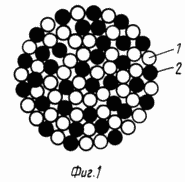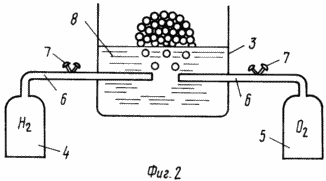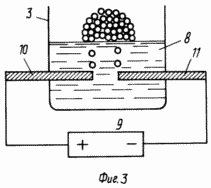| Start of section
Production, amateur Radio amateurs Aircraft model, rocket-model Useful, entertaining |
Stealth Master
Electronics Physics Technologies Inventions |
Secrets of the cosmos
Secrets of the Earth Secrets of the Ocean Tricks Map of section |
|
| Use of the site materials is allowed subject to the link (for websites - hyperlinks) | |||
Navigation: => |
Home / Patent catalog / Catalog section / Back / |
|
INVENTION
Patent of the Russian Federation RU2047910
![]()
PHYSICAL MODEL OF BALL LIGHTNING AND DEVICE FOR ITS IMPLEMENTATION (VARIANTS)
The name of the inventor: Kurakin VI; Shoromov N.P.
The name of the patent holder: Scientific and Technical Club "Vulcan"
Address for correspondence:
The effective date of the patent: 1992.07.01
Usage: in atmospheric physics, the device is designed to simulate processes in ball lightning. SUMMARY OF THE INVENTION: A physical model of ball lightning is a mixture of a combustible gas with an oxidant and a skeleton. The frame is made in the form of a foam, the bubbles of which are filled with hydrogen and oxygen, and are intermixed. The walls of the bubbles are obtained from an aqueous solution of a surfactant and a catalyst for the oxidation of hydrogen in oxygen. The device for implementing the model comprises a source of combustible gas, an oxidant source and a source of the carcass. Sources of gases are made in the form of cylinders with compressed gases of hydrogen and oxygen, and the chamber in the form of a vessel with an aqueous solution. The device variant has an electrolyzer with two electrodes in the chamber.
DESCRIPTION OF THE INVENTION
The invention relates to atmospheric physics and is intended for the creation and investigation of artificial analogues of ball lightning.
Physical models of ball lightning (analogs) are known, which are a mixture of combustible gases with air oxygen (Barry DD Ball lightning and lightning bolt, M. Mir, 1983, p.288). In the process of oxidation of combustible gases in oxygen, energy is released, the gas mixture is heated and luminescence appears.
Known are devices for implementing physical models of ball lightning. They contain a chamber to which pipes from sources of combustible gas and oxidant are brought. However, these models of ball lightning are either formless and have the appearance of a flame, or take the form of a chamber.
A physical model of ball lightning is known, based on a cluster, fractal theory. The physical model of ball lightning contains combustible substances, an oxidizer and a skeleton. In this model, the framework is a fractal cluster, and in a particular case has a threadlike structure.
A device for implementing a physical model of ball lightning is also known, which contains a source of combustible gas, an oxidizer source and a source of skeleton material fed to the chamber. The disadvantage of the known physical model of ball lightning and the device for its implementation is the weak retention of combustible gases in the filamentary framework, which leads to a short lifetime of lightning.
The technical goal of the invention is to prolong the lifetime of the physical model of ball lightning and to increase the stability of its existence.
The technical result is achieved by the fact that in the physical model of a ball lightning containing a combustible gas, an oxidizing agent and a skeleton, the frame is made in the form of a foam consisting of bubbles made with hydrogen as a combustible gas and oxygen as an oxidizer, the bubbles with hydrogen and oxygen being mixed between And the walls of the bubbles consist of water and contain surfactants and a catalyst for the oxidation of hydrogen by oxygen.
This is achieved by the fact that in the device for implementing the described model of ball lightning containing a source of combustible gas, the source of the oxidizing agent and the source of the skeleton material supplied to the chamber, the source of the combustible gas and the source of the oxidant are made in the form of two cylinders with compressed hydrogen and oxygen respectively, This tube from the cylinders through the reducers is fed to the capillaries placed by their outlets at the bottom of the chamber, which is filled with an aqueous solution with a surfactant and an oxidation catalyst.
In another embodiment of the device, in order to achieve a technical result in an apparatus for implementing a physical model of a ball lightning containing a source of a combustible gas, an oxidant source and a source of scaffold material supplied to the chamber, a source of combustible gas and an oxidizer source are arranged in the form of an electrode A current source with a voltage equal to the voltage of the electrolytic decomposition of water, the chamber being filled with an aqueous solution with a surfactant and an oxidation catalyst.
 |
 |
 |
In Fig. 1 shows the physical model of ball lightning, a section; FIG. 2 is a schematic diagram of an apparatus for implementing a physical model of a ball lightning; FIG. In Fig. 3 version of the device.
The physical model of ball lightning is a clot of foam in the form of a ball consisting of water bubbles (pores) with hydrogen 1 and bubbles with oxygen 2. The device for implementing the model contains a chamber 3 in the form of a vessel, a cylinder with hydrogen 4 and a cylinder with oxygen 5. Tubes 6 from cylinders through reducers 7 are fed into chamber 3 filled with an aqueous solution of 8 surfactant and an oxidation catalyst. The embodiment of the device (FIG. 3) comprises an electrolyzer 9 with electrodes 10 and 11.
A specific embodiment of the invention is as follows
As sources of combustible gas and oxidizer, 10-liter cylinders with a gas pressure of up to 100 atm are taken. Capillary tubes have a diameter of 0.5-1.0 mm. The size of the camera is 200x200x300 mm. Soap or shampoo is used as a surfactant, which reduces the surface tension of water. The catalyst is iron oxides in finely dispersed form with particle sizes of 0.1-1 μm. When electrolysis of water is used to produce hydrogen and oxygen, carbon rods of 10 cm in length and 5 cm in diameter are used as electrodes. A voltage of 0.5-1.5 V, the decomposition voltage of water is supplied to the electrodes.
The physical model of ball lightning is carried out by devices as follows. As a result of the supply of hydrogen and oxygen (FIG. 2), hydrogen bubbles with hydrogen 1 and bubbles with oxygen 2 are formed from the hydrogen cylinder 4 and the oxygen cylinder 5 through the tubes 6 through the reducer 7, which, rising to the surface of the water and mixing Among themselves, form, in the presence of surfactants, foam, and from it a physical model of lightning.
The physical model simulates ball lightning as follows. Vesicles, bursting and merging, mix hydrogen with oxygen, which on the catalyst contained in the solution of the walls of the bubbles, react, resulting in the release of heat and glow. This process lasts a long time, while there is a foam-like form.
CLAIM
1. A physical model of ball lightning, comprising a combustible gas, an oxidant and a skeleton, characterized in that the frame is made in the form of a foam consisting of bubbles filled with a combustible gas as hydrogen, and as an oxidizing agent with oxygen, the bubbles with hydrogen and oxygen Are intermixed, and the walls of the bubbles are composed of water and contain surfactants and a catalyst for the oxidation of hydrogen by oxygen.
2. An apparatus for implementing a physical model of ball lightning, comprising a source of a combustible gas, an oxidant source and a source of a scaffold material supplied to the chamber, characterized in that the source of the combustible gas and the oxidizer source are made in the form of two cylinders with compressed hydrogen and oxygen, respectively, Tubes from cylinders through reducers are led to capillaries placed by their outlets at the bottom of the chamber, which is filled with an aqueous solution with a surfactant and an oxidation catalyst.
3. An apparatus for implementing a physical model of a ball lightning, comprising a source of a combustible gas, an oxidant source and a source of skeleton material supplied to the chamber, characterized in that the source of the combustible gas and the oxidant source are in the form of electrodes placed on the bottom of the chamber connected to a current source c Voltage equal to the voltage of the electrolytic decomposition of water, the chamber being filled with an aqueous solution with a surfactant and an oxidation catalyst.
print version
Published on February 15, 2007




Comments
Commenting on, remember that the content and tone of your message can hurt the feelings of real people, show respect and tolerance to your interlocutors even if you do not share their opinion, your behavior in the conditions of freedom of expression and anonymity provided by the Internet, changes Not only virtual, but also the real world. All comments are hidden from the index, spam is controlled.